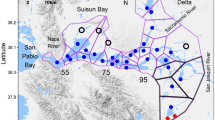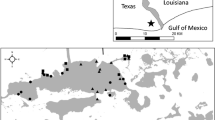Abstract
The ability to detect and to develop a precise and accurate estimate of the entrainment mortality fraction is an important step in projecting power plant impacts on future fish population levels. Recent work indicates that these mortailities may be considerably less than 100% for some fish species in the early life stages. Point estimates of the entrainment mortality fraction have been developed based on probabilistic arguments, but the precision of these estimates has not been studied beyond the simple statistical test of the null hypothesis that no entrainment mortaility exists.
The ability to detect entrainment mortality is explored as a function of the sample sizes (numbers of organisms collected) at the intake and discharge sampling stations of a power plant and of the proportion of organisms found alive in the intake samples (intake survival). Minimum detectable entrainment mortality, confidence interval width, and type II error (probability of accepting the null hypothesis of no entrainment mortality when there is mortality) are considered. Increasing sample size and/or decreasing sampling mortality will decrease the minimum detectable entrainment mortality, confidence interval width, and type II error for a given level of type I error.
The results of this study are considered in the context of designing useful monitoring programs for determining the entrainment mortality fraction. Preliminary estimates of intake survival and the entrainment mortality fraction can be used to obtain estimates of the sample size needed for a specified level of confidence interval width or type II error. Final estimates of the intake survival and the entrainment mortality fraction can be used to determine the minimum detectable entrainment mortality and the type II error.
Similar content being viewed by others
Literature cited
Barnthouse, L. W., J. B. Cannon, S. W. Christensen, A. H. Eraslan, J. L. Harris, K. H. Kim, M. E. LaVerne, H. A. McLain, B. D. Murphy, R. J. Raridon, T. H. Row, R. D. Sharp, and W. Van Winkle. 1977.A selective analysis of power plant operation on the Hudson River with emphasis on the Bowline Point generating station. ORNL/TM-5877 (Volume 2). Oak Ridge National Laboratory, Oak Ridge, TN. Chapter 5.3. 966 pp.
Beck, A. D., E. J. Carpenter, C. C. Coutant, B. Kinsman, B. C. Marcy, Jr., R. P. Morgan III, A. S. Robbins, J. R. Schubel, R. E. Ulanowicz, and P. M. J. Woodhead. 1978. On selecting the excess temperature to minimize the entrainment mortality rate. Pages 211–227in J. R. Schubel and B. C. Marcy, Jr. (eds), Power plant entrainment: A biological assessment. Academic Press, NY. Chapter 6.
Boreman, J., L. W. Barnthouse, D. S. Vaughan, C. P. Goodyear, S. W. Christensen, K. D. Kumar, B. L. Kirk, and W. Van Winkle. Entrainment Impact Estimates for Six Fish Species Inhabiting the Hudson River Estuary. Volume Iof The Impact of Entrainment and Impingement on Fish Populations in the Hudson River Estuary. ORNL/NUREG/TM-385/VI. Oak Ridge National Laboratory, Oak Ridge, TN. (In press).
Boreman, J., and C. P. Goodyear. 1981. Biases in the estimation of entrainment mortality. Pages 79–89in L. D. Jensen (ed.),Issues Associated with Impact Assessment: Proceedings of the Fifth National Workshop on Entrainment and Impingement. Ecological Analysts, Inc., Sparks, MD.
Cada, G. F., J. S. Suffern, K. D. Kumar, and J. A. Solomon. 1981. Investigations of entrainment mortality among larval and juvenile fishes using a power plant simulator. Pages 111–122in L. D. Jensen (ed.),Issues Associated with Impact Assessment: Proceedings of the Fifth National Workshop on Entrainment and Impingement. Ecological Analysts, Inc., Sparks, MD.
Cannon, T. C., S. M. Jinks, L. R. King, and G. J. Lauer. 1977. Survival of entrained ichthyoplankton and macroinvertebrates at Hudson River power plants. Pages 71–89in L. D. Jensen (ed.),Proceedings of the Fourth National Workshop on Entrainment and Impingement. Ecological Analysts, Inc., Melville, NY.
Fleiss, J. L. 1973.Statistical methods for rates and proportions. John Wiley and Sons, NY. 223 pp.
Gardner, R. H., R. V. O'Neill, J. B. Mankin, and K. D. Kumar. 1980. Comparative error analysis of six predator-prey models.Ecology 61: 323–332.
Ginn, T. C., G. V. Poje, and J. M. O'Connor. 1977. Survival of planktonic organisms following passage through a simulated power plant condenser tube. Pages 91–101in L. D. Jensen (ed.),Proceedings of the Fourth National Workshop on Entrainment and Impingement. Ecological Analyst, Inc., Melville, NY.
Herbes, S. E., and J. J. Beauchamp. 1977. Toxic interaction of mixtures of two coal conversion effluent components (resorcinol and 6-methylquinoline) toDaphnia magna.Bulletin Environmental Contamination and Toxicolology 17: 25–32.
Jinks, S. M., S. D. Jacobson, D. Latimer, and M. E. Loftus. 1981. Advances in techniques for assessment of ichthyoplankton entrainment survival. Pages91–101in L. D. Jensen (ed.),Issues Associated with Impact Assessment: Proceedings of the Fifth National Workshop on Entrainment and Impingement. Ecological Analysts, Inc., Sparks, MD.
McGroddy, P. M., and R. L. Wyman. 1977. Efficiency of nets and a new device for sampling living fish larvae.Journal of Fisheries Research Board of Canada 34: 571–574.
Marcy, B. C., Jr., A. D. Beck, and R. E. Ulanowicz. 1978. Effects and impacts of physical stress on entrained organisms. Pages 135–188in J. R. Schubel and B. C. Marcy, Jr. (eds.),Power plant entrainment: A biological assessment. Academic Press, NY. Chapter 4.
Morgan, R. P., II., and E. J. Carpenter, 1978. Biocides. Pages 95–134in J. R. Schubel and B. C. Marcy, Jr. (eds.),Power plant entrainment: A biological assessment. Academic Press, NY. Chapter 3.
O'Neill, R. V. 1973. Error analysis of ecological models. Pages 898–908in D. J. Nelson (ed.),Radionuclides in Ecosystems. CONF-710501. National Technical Information Service, Springfield, VA.
O'Neill, R. V., and R. H. Gardner. 1979. Sources of uncertainty in ecological models. Pages 447–463in B. P. Zeigler, M. S. Elzas, G. J. Klir, and T. I. Oren (eds.),Methodology in systems modelling and simulation. North-Holland Publishing Company, Amsterdam.
Schubel, J. R., C. C. Coutant, and P. M. J. Woodhead. 1978. Thermal effects of entrainment. Pages 19–93in J. R. Schubel and B. C. Marcy, Jr. (eds.),Power plant entrainment: A biological assessment. Academic Press, NY. Chapter 2.
Vaughan, D. S., and K. D. Kumar. 1981.Detectability and precision of estimates of entrainment mortality of ichthyoplankton. ORNL/NUREG/TM-435. Oak Ridge National Laboratory, Oak Ridge, TN. 87 pp.
Author information
Authors and Affiliations
Rights and permissions
About this article
Cite this article
Vaughan, D.S., Kumar, K.D. Entrainment mortality of Ichthyoplankton: Detectability and precision of estimates. Environmental Management 6, 155–162 (1982). https://doi.org/10.1007/BF01871434
Issue Date:
DOI: https://doi.org/10.1007/BF01871434




